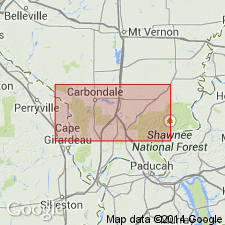
- Usage in publication:
-
- Kinkaid limestone
- Modifications:
-
- Named
- Dominant lithology:
-
- Limestone
- Shale
- AAPG geologic province:
-
- Illinois basin
Summary:
Named Kinkaid limestone. Consists of regular beds of limestone with hummocky surfaces about 1 ft in thickness separated by thin shaly seams. Varies greatly in thickness. Greatest thickness is 140 ft. Underlain by Degonia sandstone; overlain unconformably by Pennsylvanian rocks.
Source: GNU records (USGS DDS-6; Reston GNULEX).
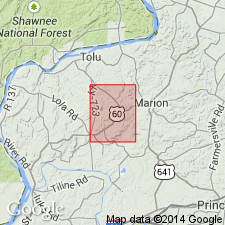
- Usage in publication:
-
- Kinkaid Limestone*
- Modifications:
-
- Overview
- AAPG geologic province:
-
- Illinois basin
Summary:
Designated Kinkaid Limestone in westernmost KY. "Limestone, light- to dark-gray, finely crystalline; low insoluble content; beds commonly 1 foot thick; abundant fossil fragments. Forms thin ledges." Thickness is 35+/-ft. Underlain by Degonia Sandstone; overlain by Pennsylvanian Caseyville Formation. Lumped with Degonia Sandstone and Clore Limestone for mapping purposes.
Source: GNU records (USGS DDS-6; Reston GNULEX).
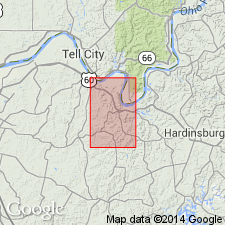
- Usage in publication:
-
- Kinkaid Limestone Member*
- Modifications:
-
- Revised
- AAPG geologic province:
-
- Illinois basin
Summary:
Kinkaid Limestone reduced in rank to Kinkaid Limestone Member of Buffalo Wallow Formation for use in local area in western KY. Forms uppermost part of Buffalo Wallow. "Limestone, grayish-brown, aphanitic, hard, dense; generally thick-bedded to massive and weathers white but upper beds are thin and weather yellowish brown. Contains brachiopods, gastropods, corals, large bryozoans, crinoid stems." Underlain by lower part of Buffalo Wallow; overlain by Pennsylvanian Caseyville and Tradewater Formations.
Source: GNU records (USGS DDS-6; Reston GNULEX).
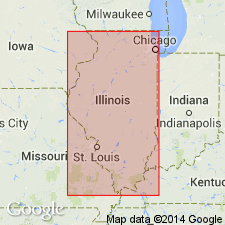
- Usage in publication:
-
- Kinkaid Limestone
- Modifications:
-
- Overview
- AAPG geologic province:
-
- Illinois basin
Summary:
Current (1975) usage of the Illinois Geological Survey is Kinkaid Limestone. Divided into three formal members. The lowest, Negli Creek Limestone Member, is massive limestone, commonly brownish gray, very fine grained, cherty particularly in upper part. It is 16 to 37 ft thick. The middle member, Cave Hill Shale Member, is a limestone and shale unit that is 65 to 90 ft thick. The upper member, the Goreville Limestone Member, is resistant and relatively uniform, massive, brownish-gray, very fine grained limestone. It is cherty to slightly cherty nearly everywhere. Ranges in thickness from 25 to 50 ft. The Kinkaid overlies the Degonia Sandstone; overlain by Grove Church Shale except where unconformably overlain by Pennsylvanian rocks.
Source: GNU records (USGS DDS-6; Reston GNULEX).
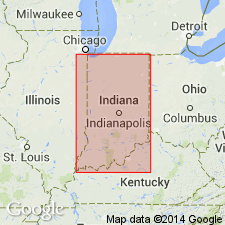
- Usage in publication:
-
- Kinkaid Limestone
- Modifications:
-
- Overview
- AAPG geologic province:
-
- Illinois basin
Summary:
Current (1986) usage of Indiana Geological Survey is Kinkaid Limestone of Buffalo Wallow Group. "In Indiana the name Kinkaid Limestone is now restricted to subsurface usage. Where the formation is not greatly reduced by pre-Pennsylvanian erosion, it is 130 to 150 feet thick and is divisible informally into three members. The uppermost member is 18 to 20 feet thick and consists of gray to gray-tan coarse to fine grainstone to packstone and minor amounts of chert. The middle member is 80 to 100 feet thick and is predominantly dark gray shale, but it also includes minor amounts of red and green shale. The lower member is 18 to 20 feet thick and is tan-gray to brown medium to very fine grainstone to mudstone." Conformably overlies Degonia Sandstone, disconformably underlies Pennsylvanian Mansfield Formation except in few places in Posey Co. where overlain by Mississippian Grove Church Shale.
Source: GNU records (USGS DDS-6; Reston GNULEX).
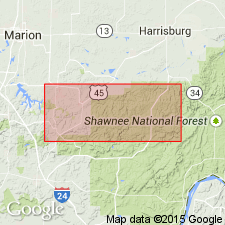
- Usage in publication:
-
- Kinkaid Limestone
- Modifications:
-
- Revised
- AAPG geologic province:
-
- Illinois basin
Summary:
Authors here revise Grove Church Shale (of Swann, 1963) as Grove Church Member of Kinkaid Limestone as it does not meet the test of mappability required by the 1983 Code. Interbedded shale and limestone of the Grove Church are lithologically similar to the rest of the Kinkaid. Ascending Negli Creek Limestone, Cave Hill, and Goreville Limestone Members also traceable in outcrop and subsurface in southern IL. Thickness of the Kinkaid varies from a minimum of 85 ft to a maximum of 230 ft in the Creal Springs quad. Unit averages 120 to 160 ft. Unconformably underlies Caseyville Formation; overlies Degonia Formation. Kinkaid is Chesterian.
Source: GNU records (USGS DDS-6; Reston GNULEX).
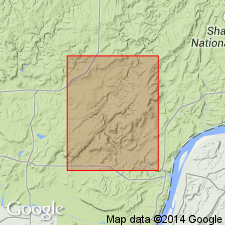
- Usage in publication:
-
- Kinkaid Limestone
- Modifications:
-
- Revised
- AAPG geologic province:
-
- Illinois basin
Summary:
The Pope Group, here revised from Megagroup and apparently reinstated, comprises strata from the base of the Aux Vases Sandstone to the top of the Kinkaid Formation. According to authors, "The Pope Group is a lithostratigraphic unit distinct from its chronostratigraphic counterpart, the Chesterian Series." The lower boundaries of the two differ slightly. The group is about 1,425 ft thick in the Waltersburg quad, but the lowermost formations, from the Aux Vases Sandstone up to the Fraileys Shale Member of the Golconda Formation do not crop out. This interval is 384 ft thick in the Austin Roberts No. 1 Well. [See subunit list in index portion of Pope summary record. Publication does not name the units between the Aux Vases and the Fraileys and therefore these have not been included in the list.]
Source: GNU records (USGS DDS-6; Reston GNULEX).
For more information, please contact Nancy Stamm, Geologic Names Committee Secretary.
Asterisk (*) indicates published by U.S. Geological Survey authors.
"No current usage" (†) implies that a name has been abandoned or has fallen into disuse. Former usage and, if known, replacement name given in parentheses ( ).
Slash (/) indicates name conflicts with nomenclatural guidelines (CSN, 1933; ACSN, 1961, 1970; NACSN, 1983, 2005, 2021). May be explained within brackets ([ ]).

